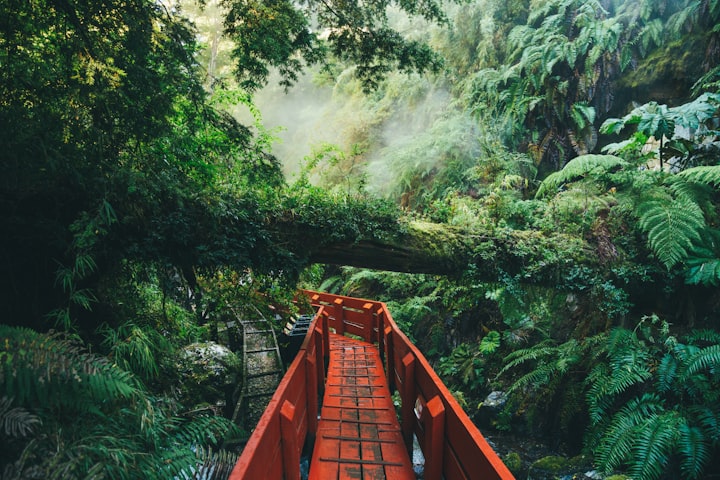Bury Me Then Plant a Tree
Passiliran: Traditional Tree Burials of Tana Toraja

Within the Philippines, deep in South Sulawesi, there is a grove of Tarra trees that have strange little patch marks going up and down their trunks. They look like a roof thatching carved into the side of the tree. Behind those patches is a morbid tradition that I find fascinating, disturbing, and beautiful all at once. This is something I discovered by accident and yet I cannot unlearn now that I know it. I am debating if I will adapt this idea into the novels, because it definitely fits my fantasy world’s religion. My fantasy world is not based on facts though. So here is my obscure truth and how I discovered it.
Since reaching adulthood I have noticed myself grow progressively more morbid. This past year hardly helped as I obsessively followed the death counts, and used dark humor to cope with my own crumbling mental health. Yet when I think of my own morbidity it is neither a wry sense of humor nor an overwhelming depression that is at the forefront. I think about my own death as a passage on to the next stage of my soul’s existence. I have written multiple poems on the subject. They always emerge when I am in a state of meditation rather than a moment of grief or fear.
I hope something spreads its roots
through the ashes of my soul.
Bury me then plant a tree
upon some starry knoll
That way you can visit
But I can still explore
By spreading my branches
and reaching my roots more.
I have always loosely had the idea that after my life had expired I would return my body to the Earth. I can pinpoint two cultural sources from my childhood that gave me this concept. The first is Mufasa’s speech about the Circle of Life in the Lion King.
As a child, I latched onto the idea that when my soul left this world, the energy I left behind could be used by other plants and animals. Perhaps this concept was helped by a biologist older brother who used to collect mushroom prints. He explained to me, as we collected fungi, that their role in the ecosystem was to break down dead and dying plants or animals into a form that other living kingdoms could use. So even at six or seven it just made sense to me that the circle of life included decomposition
The idea of corpses specifically becoming soil I blame on the second, sillier, cultural source of “The Hearse Song.” If you are unfamiliar with the song, it depicts the journey of a corpse from the hearse into the ground where the worms delight and feast on the dead body. I remember singing that song with my siblings all the way up to the “The worms play pinochle on your snout.” We'd sing it in the car, when we were about to play pinochle, or walking through the cemetery. I swear, my family did not have some weird obsession with death. We lived right by the cemetery and it was about a quarter of a mile to walk through the cemetery to the local town. It was commonplace for us, just like the Hearse song was just something silly to sing. I tried to find a silly little version to embed into this story, but almost all versions for sale focus on fear elements so here is a super scary cover by Harley Poe.
Sure, the song lyrics are about imagining your own decaying body, but those worms sure get a party. We always considered it a bit of a silly song, but the idea that worms might decompose my body was reinforced in my brain everytime I fed the worms in our compost bin. The idea was fixed in my brain so early that the first funeral I attended I was surprised to see the shiny weather resistant box. I don’t really like the idea of having a coffin sealed from the world. I took energy from the world around me in the food I consumed. I don’t need to hoard that energy in my body by sealing my body with a waterproof coffin or in a crypt. I am not a vampire; I don’t think I’ll need my body again once I die.
These are all lovely personal reflections, but I did promise facts. I could talk about how World War I Soldiers sang The Hearse Song. I could also investigate the similarities between the Circle of Life and Buddhism. I could dive into details about Recompose, the funeral home that can legally compost a human remains in the United States. I have a little more flow of consciousness before I reach my fascinating facts, but I ask you to follow me down the rabbit hole a little further.
When I wrote the poem at the beginning of this article I began wondering about the logistics. What type of tree would “spread its roots in the ashes of my soul” if I were cremated then buried. There is not a lot publicly posted about what trees flourish when fertilized by cremated human flesh. I was researching this before Recompose existed, which incidentally does offer a list of suggested plants or locations where your composted flesh could be used once it has turned to soil. However, at the time I input a variety of phrases into my search including the words tree, funeral, and burial. That was how I stumbled upon the Passiliran.
The Tana Toraja caretake a grove of Tarra trees that have strange little patch marks going up and down their trunks. They look like a roof thatching carved into the side of the tree. Buried, behind each of those patches lies a babe swaddled in cloth wrappings who breathes no more. When an infant dies before having received their first teeth, their family completes a ritual called Passiliran. They sacrifice a pig the same day they bury their child within the hollowed out trunk of a living Tarra tree. Inside the family places a chicken egg to symbolize the purity of the one who died too soon. Then they seal their loved one into the tarra tree with roof-like thatching.
The tarra tree serves as a nursery of sorts for young souls. The tree emits sap like a mothers milk and allows the nutrients to live on in a new form. The child is not considered dead, but reborn in the form of the plant. It can provides a symbolic healing for the mother so that she will be able to grow another child in her womb that can live longer. Those grieving the loss can continue to visit the grave for years see evidence of life in fresh branches emerging through the patches. It is both a beautiful and heartbreaking concept.
The Tana Toraja are known for their complex funeral rituals and beliefs. They practice a form of animism, or the belief that plants or inanimate objects can retain souls. For adults, funerals are lavish affairs involving sacrificing animals to feed those attending. Sometimes the dead are kept in the same house as the living for months or even years after passing while the family saves for the expensive funeral. Unlike my wormy vision of death or the absorption of the tree, the dead are preserved. They are placed in their cliffside burials where no worms can crawl in or out. The family periodicaly exhumes and dresses their dead relative for a special family reunion called Ma’Nene. The Tana Toraja actually have a thriving tourist industry based on their burial rituals. I found out a lot more about the underlying culture in researching about the Tarra trees.
Many of us had to face death this year. I don’t know when my own death will come or that of those I love, but I do know when the time comes for me it won’t be the end. Not completely. My nutrients will give life to other living beings like those in that nursery tree in the Philippines. New life will spring from behind the patch.

For more information regarding the Tarra trees and Passiliran ritual please reference the articles and videos below.
https://idbackpacker.com/bori-parinding-tarra-tree-story/
https://indonesiakaya.com/pustaka-indonesia/passiliran/
https://youtu.be/ER4ybQt9yLk
https://www.dailymail.co.uk/news/article-3270383/The-tree-graves-Indonesia-dead-babies-buried-inside-trunks-growing-plants-absorbed-nature.html
For information about the Tana Toraja’s funeral rites in general can be found at the articles and videos below.
https://www.amusingplanet.com/2015/03/the-peculiar-burial-rites-of-tana-toraja.html
https://www.youtube.com/watch?v=mUH6d6YJ9M8
https://www.youtube.com/watch?v=knBnQUsj2xo
https://www.youtube.com/watch?v=yLgua5LtZhk
https://www.ripleys.com/weird-news/tana-toraja/
For information regarding human composting: https://www.seattletimes.com/life/recompose-the-first-human-compositing-funeral-home-in-the-u-s-is-now-open-for-business/
About the Creator
Lucy Alice Dickens
Lucy Alice was born and raised in western Washington state. She spent much of her formative years exploring the Olympic Rainforest with her family. She is an Army Veteran who writes poetry, essays, and fictional stories long and short.






Comments
There are no comments for this story
Be the first to respond and start the conversation.